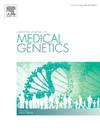Identifying patients with neurofibromatosis type 1 related optic pathway glioma using the OMOP CDM
IF 1.7
4区 医学
Q3 GENETICS & HEREDITY
引用次数: 0
Abstract
Neurofibromatosis type 1 (NF1) is a rare tumour predisposition syndrome. Optic pathway gliomas (NF1-related OPG) are a well-characterised tumour type. There is great need for tools that can efficiently identify patients with NF1-related OPG at hospitals. Computable phenotypes algorithms can be used to find patients with certain clinical features in an electronic database. We developed computable phenotype algorithms using the Observational Medical Outcome Partnership (OMOP) Common Data Model. We subsequently assessed if these algorithms could identify patients with NF1-related OPG in an electronic health records (EHR) derived database. We created phenotype algorithms based on diagnosis codes, visits, and radiologic procedures. These phenotypes were applied to the EHR-derived database of an academic hospital. To assess the performance of the phenotypes, we calculated the precision, recall, and F2 score against a list of known cases (n = 61), provided by a clinician. To evaluate the ability of the phenotypes to identify additional cases, we manually reviewed the predicted positives of each phenotype algorithm. The phenotype algorithm based on the diagnosis codes ‘Neurofibromatosis syndrome’ and ‘Neoplasm of optic nerve’ performed best (precision = 1.000, recall = 0.614, F2-score = 0.665). The phenotype ‘Neurofibromatosis syndrome and three or more Ophthalmology visits and one or more MRI of brain’ performed best of the phenotypes based on visits and radiologic procedures (precision = 0.489, recall = 0.511, F2-score = 0.507). Generally, increased precision came at the cost of a decrease in recall. Following review of the predicted positives of each phenotype, 27 additional cases were identified. OMOP computable phenotype algorithms successfully identified NF1-related OPG patients in an EHR-derived database. They provided swift insight into the number of NF1-related OPG cases and were able to identify additional cases, which were not included in the original list of known cases. Phenotype algorithms created with OMOP could be an invaluable tool to facilitate patient screening, especially in multi-centric trials for rare diseases.

利用OMOP CDM鉴别1型神经纤维瘤病相关视神经通路胶质瘤患者。
1型神经纤维瘤病(NF1)是一种罕见的肿瘤易感性综合征。视神经胶质瘤(nf1相关的OPG)是一种特征明确的肿瘤类型。医院非常需要能够有效识别nf1相关OPG患者的工具。可计算表型算法可用于在电子数据库中寻找具有某些临床特征的患者。我们使用观察性医疗结果伙伴关系(OMOP)公共数据模型开发了可计算的表型算法。我们随后评估了这些算法是否可以在电子健康记录(EHR)衍生数据库中识别nf1相关的OPG患者。我们根据诊断代码、就诊和放射检查程序创建了表型算法。将这些表型应用于一家学术医院的ehr衍生数据库。为了评估表现型的表现,我们根据临床医生提供的已知病例列表(n=61)计算了精确度、召回率和F2评分。为了评估表型识别其他病例的能力,我们手动审查了每种表型算法的预测阳性。基于诊断代码“神经纤维瘤综合征”和“视神经肿瘤”的表型算法表现最好(准确率=1.000,召回率=0.614,F2-score=0.665)。“神经纤维瘤综合征和三次或三次以上眼科检查以及一次或多次脑部MRI检查”的表型在基于就诊和放射检查的表型中表现最好(精度=0.489,召回率=0.511,F2-score=0.507)。一般来说,精确度的提高是以召回率的降低为代价的。在对每种表型的预测阳性进行审查后,又确定了27例病例。OMOP可计算表型算法在ehr衍生的数据库中成功识别出nf1相关的OPG患者。他们迅速了解了nf1相关OPG病例的数量,并能够识别未包括在原始已知病例列表中的其他病例。使用OMOP创建的表型算法可能是促进患者筛查的宝贵工具,特别是在罕见疾病的多中心试验中。
本文章由计算机程序翻译,如有差异,请以英文原文为准。
求助全文
约1分钟内获得全文
求助全文
来源期刊
CiteScore
4.10
自引率
0.00%
发文量
193
审稿时长
66 days
期刊介绍:
The European Journal of Medical Genetics (EJMG) is a peer-reviewed journal that publishes articles in English on various aspects of human and medical genetics and of the genetics of experimental models.
Original clinical and experimental research articles, short clinical reports, review articles and letters to the editor are welcome on topics such as :
• Dysmorphology and syndrome delineation
• Molecular genetics and molecular cytogenetics of inherited disorders
• Clinical applications of genomics and nextgen sequencing technologies
• Syndromal cancer genetics
• Behavioral genetics
• Community genetics
• Fetal pathology and prenatal diagnosis
• Genetic counseling.

 求助内容:
求助内容: 应助结果提醒方式:
应助结果提醒方式:


